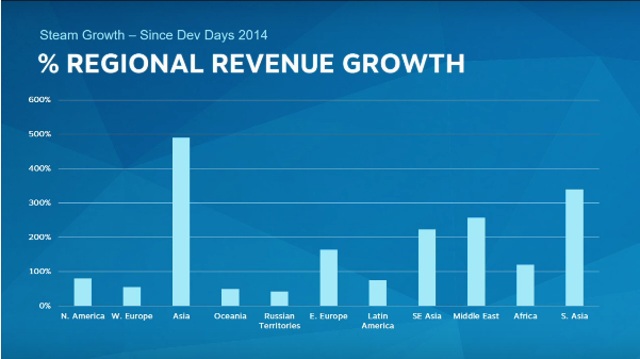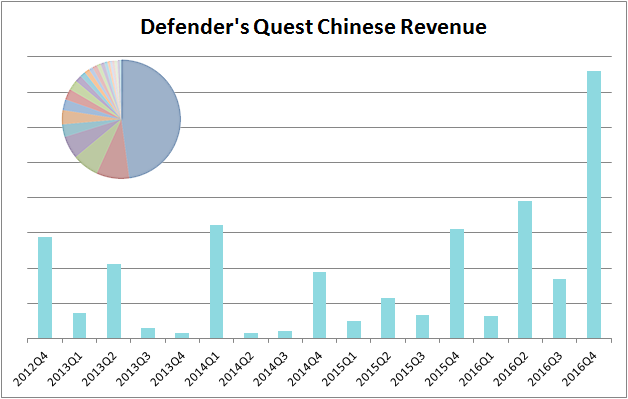For the past five years I've been maintaining Defender's Quest, I've kept telling myself: there's got to be some magical untapped audience I've yet to reach. I've tried every possible trick to find them, and while many have helped, none have been a silver bullet.
Support Mac and Linux
5.2% and 1.8% of lifetime revenue, respectively
Participate in Humble bundles
(back when they were really good)
Sell direct, on GOG, Itch.io, etc
significant chunk, still dwarfed overall by Steam
Localize all the things
Professional: German, French, Spanish, Japanese
Volunteer: Russian, Korean, Italian, Czech
Probably worth it? But not crystal clear.
Well, I finally found these magical undiscovered players: they're in China.
In "Steam Discovery 2.0, Stegosaurus Tail 2.0", we noted the trend of Chinese players appearing on the global PC gaming radar.
For one, Valve mentioned the trend at Dev Days 2016:

and I had noticed it myself, both anecdotally:

as well as in our revenue reports:

At the time, China was still a very small slice of our overall revenue (as you can see in the graph's embedded pie chart -- it's the tiny turquoise slice at the very top). Still, it was enough evidence to start localizing Defender's Quest into Simplified and Traditional Chinese.
Now, whether or not localization is worth it depends on how much text the game has. And Defender's Quest has a lot of text.
Category | # words |
|---|---|
Cutscenes | 22,196 |
Journal | 24,943 |
Everything else | 8,709 |
Total | 55,848 |
The Cutscenes and Journal together comprise a small novel -- 47,139 words, about the same length as Slaughterhouse Five. We decided to translate only the "everything else" category: the game would be completely playable in Chinese, but the story content would remain in English. This way we could test the waters, and if initial results were good, we'd follow up with a complete translation.
Spoiler alert: results were good.
I have never had a localization pay for itself this quickly, not to mention this unambiguously. When you localize a game, you are betting that sales from the target region will increase more than they would have had you not done it. Usually, however, you're never quite sure how many regional sales you would have made anyways. For example, my first language is Norwegian, and most Norwegians my age speak fluent English and consume lots of English media. Chances are they'll buy a game whether it's localized into Norwegian or not. This effect is so bad that prominent Norwegian games like OwlBoy aren't even localized into the developer's native language. (Same goes for um... Defender's Quest. Tilgi meg, Bestemor!) But what about Germans? There's a lot more of them, and research says they have a stronger preference for native-language media than Norwegians. So we did a German localization (among others). And it was probably worth it, but the effect was somewhat obscured since Germany was already a strong selling region.
The Chinese stats tell a completely different story.
Stats
For context, when we updated the game with Traditional and Simplified Chinese translations, we ran a Steam weekly deal at 50% off and popped one of our visibility tokens (see this article).
Result: China was our #1 sales region, not only in terms of units sold, but also in terms of gross revenue.
Last week's sale figures:

As mentioned previously, the before/after results of localization were completely unambiguous.

Of all the revenue Defender's Quest has earned from China on Steam in its entire lifetime, 45% of it was earned last week. That's right, we basically doubled our lifetime sales from China almost immediately! Obviously there's some degree of "pent-up demand" in play here, but based on other developers' experience, I suspect we'll see improved sales from China in our long tail, as well.
Here's a per-country breakdown for our lifetime sales, excluding this past week (ie, the entire time before the Chinese localizations were availalbe):

Back then, China was #22.
"But, Lars!" you say, "Defender's Quest has been on sale for five long years! Maybe it's already soaked up most of its potential western buyers already?"
Judging from 2016's figures, apparently not:

The same 10 countries that dominated lifetime sales show up here, just with a few positions swapped. The biggest change is that Japan and Korea represent a larger overall share in 2016 vs. overall lifetime (We shipped Korean and Japanese localizations in 2014). And the Anglosphere + Europe still dominate.
Here's a side-by-side chart of last week vs. 2016 for easy comparison:





































